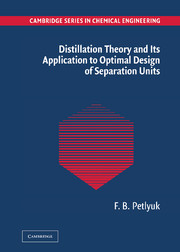Book contents
- Frontmatter
- Contents
- Preface
- Acknowledgements
- Nomenclature
- 1 Phase Equilibrium and Its Geometric Presentation
- 2 Basic Concepts of Distillation
- 3 Trajectories of Distillation in Infinite Columns Under Infinite Reflux
- 4 Trajectories of Thermodynamically Reversible Distillation
- 5 Distillation Trajectories and Conditions of Mixture Separability in Simple Infinite Columns at Finite Reflux
- 6 Distillation Trajectories in Infinite Complex Columns and Complexes
- 7 Trajectories of the Finite Columns and Their Design Calculation
- 8 Synthesis of Separation Flowsheets
- Short Glossary
- Index
- References
4 - Trajectories of Thermodynamically Reversible Distillation
Published online by Cambridge University Press: 08 August 2009
- Frontmatter
- Contents
- Preface
- Acknowledgements
- Nomenclature
- 1 Phase Equilibrium and Its Geometric Presentation
- 2 Basic Concepts of Distillation
- 3 Trajectories of Distillation in Infinite Columns Under Infinite Reflux
- 4 Trajectories of Thermodynamically Reversible Distillation
- 5 Distillation Trajectories and Conditions of Mixture Separability in Simple Infinite Columns at Finite Reflux
- 6 Distillation Trajectories in Infinite Complex Columns and Complexes
- 7 Trajectories of the Finite Columns and Their Design Calculation
- 8 Synthesis of Separation Flowsheets
- Short Glossary
- Index
- References
Summary
Introduction
Although the thermodynamically reversible process of distillation is unrealizable, it is of great practical interest for the following reasons: (1) it shows in which direction real processes should be developed in order to achieve the greatest economy, and (2) the analysis of this mode is the important stage in the creation of a general theory of multicomponent azeotropic mixtures distillation.
First investigations of thermodynamically reversible process concerned binary distillation of ideal mixtures (Hausen, 1932; Benedict, 1947). Later works concerned multicomponent ideal mixtures (Grunberg, 1960; Scofield, 1960; Petlyuk & Platonov, 1964; Petlyuk, Platonov, & Girsanov, 1964).
The analysis of the thermodynamically reversible process of distillation for multicomponent azeotropic mixtures was made considerably later. Restrictions at sharp reversible distillation were revealed (Petlyuk, 1978), and trajectory bundles at sharp and nonsharp reversible distillation of three-component azeotropic mixtures were investigated (Petlyuk, Serafimov, Avet'yan, & Vinogradova, 1981a, 1981b).
Restrictions at nonsharp reversible distillation of three-component azeotropic mixtures were studied by Poellmann and Blass (1994).
Trajectories of adiabatic distillation at finite reflux for given product points should be located in concentration space in the region limited by trajectories at infinite reflux and by trajectories of reversible distillation (Petlyuk, 1979; Petlyuk & Serafimov, 1983).
The algorithm, based on this principle and checking for three-component mixtures whether it is possible to get either products of given composition at distillation, was developed by Wahnschafft et al. (1992).
- Type
- Chapter
- Information
- Publisher: Cambridge University PressPrint publication year: 2004



